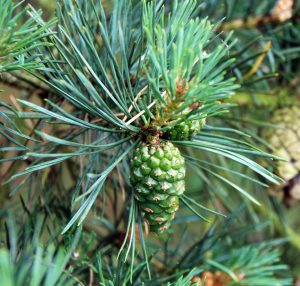Polluting Pines ?

Both carbon dioxide and methane are significant contributors to global warming and climate change. But they are not the only agents of global warming. Emissions of nitrous oxide N2O (aka laughing gas) are also rapidly increasing, mainly associated with large-scale farming using synthetic fertilisers, and the rearing of livestock. As a ‘greenhouse gas’, it is extremely potent, much more so on a gramme for gramme basis than carbon dioxide. It also interacts with the ozone layer, which protects us from the worst aspects of UV radiation.
Now recent findings on nitrous oxide emissions from trees in northern latitudes have surprised scientists. They have found that the gas is released not only from the soil but from the trees. The research group observed that the greenhouse gas nitrous oxide is released into the atmosphere not only by the soil of woodlands and forests, but also by pine, birch and spruce trees; such trees are typical of the northern boreal zone. It seems that the stems and canopies of pine trees are sources of N2O, as are those of birches and spruces. The amount of N2O released is dependent on the physiological state of the trees, being more active in Spring and Summer. It had previously been thought that trees had no significant role in the N2O balance of woodlands and forests. The researchers (from Helsinki University) demonstrated that even though boreal forests often have low nitrogen levels (available nitrogen sources often restrict tree growth), some of the nitrogen in the ecosystem is nevertheless released into the air as nitrous oxide.
Apart from N2O, some trees such as pines also release volatile organic compounds (VOCs), for example alpha-pinene. Recent research has established that these volatile compounds / vapours are not only responsible for the characteristic scent, but vitally important in the formation of aerosols found in the air in and around such woodlands and forests.
 The air around us is a mixture of different particles/aerosols. An aerosol is a ‘mixture’ of very small particles (solid or liquid) in air. These particles come from different sources : volcanoes, cars, trucks, wood fires and now trees. Examples of aerosols include mist, cigarette smoke, or car exhaust fumes. There is now evidence that the aerosols formed in and around pine trees are transformed (the atmosphere is a highly oxidising and reactive place) into particles that have a completely different chemical make-up. It is the products of human activity that change the amount and properties of these natural aerosols. The small particles from the VOC’s ‘muddy the air’.
The air around us is a mixture of different particles/aerosols. An aerosol is a ‘mixture’ of very small particles (solid or liquid) in air. These particles come from different sources : volcanoes, cars, trucks, wood fires and now trees. Examples of aerosols include mist, cigarette smoke, or car exhaust fumes. There is now evidence that the aerosols formed in and around pine trees are transformed (the atmosphere is a highly oxidising and reactive place) into particles that have a completely different chemical make-up. It is the products of human activity that change the amount and properties of these natural aerosols. The small particles from the VOC’s ‘muddy the air’.
Using smog chambers and artificial atmospheres, researchers introduced alpha-pinene and ozone and then added OH free radicals. They found that the OH radicals altered the properties and concentrations of the VOCs resulting in three times more particulate matter than was originally released into the chambers. Particles not only influence rain and cloud formation, but they also affect our health. Premature deaths from heart and lung disease have been attributed to high concentrations of aerosols, especially small particles of less than 2.5 micrometers (µM) in diameter.
For more information on air pollution and respiratory disease / problems - click here
https://www.sciencedaily.com/releases/2012/08/120809133803.htm
Comments are closed for this post.
